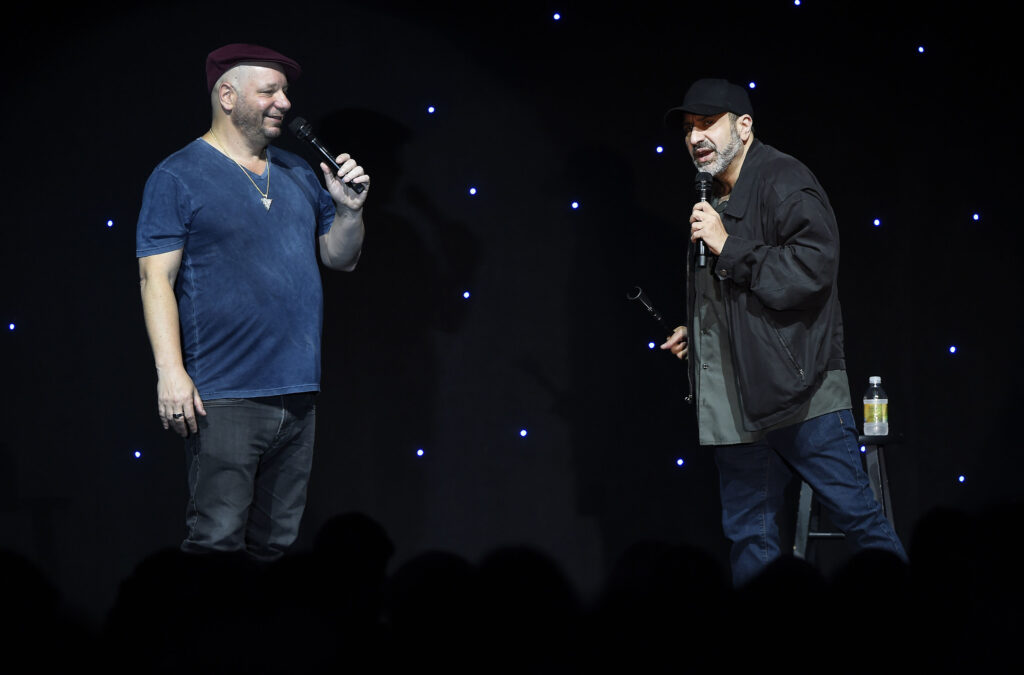By Vanessa Wojtusiak
For too long, Connecticut has been the overlooked middle child, caught between the bright lights of New York City and the historic charm of Boston, its suburban streets often seen as too quiet, too affluent and too stiff to house anything remotely edgy. Known as a place where the humor is reserved and jokes risk falling flat, it’s easy to assume that the state’s comedy scene is as buttoned-up as its residents.
But that perception couldn’t be further from the truth. Connecticut’s comedy roots run deep and in recent years, the state has undergone a dramatic transformation. What was once considered a quiet backwater for comedy has become a thriving hub for improv groups, stand-up comics and open mic nights, with both A-list comedians and local talent making their mark.
The state is now more than just a stop between cities; it has become a comedy destination in its own right.
But Connecticut’s legacy of laughter isn’t a recent development; it stretches back to the state’s earliest comedic pioneers. Mark Twain, born Samuel Clemens in Hartford, revolutionized humor with his satirical style, biting social critiques and keen observations of the human condition. His sharp wit, often laced with sarcasm, created a blueprint for the kind of intelligent comedy that still defines the state’s comedic culture today. Twain’s influence has also left a lasting mark on a national level; the prestigious Mark Twain Prize for American Humor, awarded annually by the John F. Kennedy Center for the Performing Arts, celebrates individuals who have had a profound impact on American society in ways similar to Twain. Since its inception in 1998, this award has recognized the contributions of comedy legends such as Steve Martin, Tina Fey and David Letterman, cementing Twain’s lasting impact on American humor. Similarly, Katherine Hepburn, a Connecticut native, brought her own brand of screwball comedy to the big screen, with her impeccable timing and sharp-witted performances that helped shape the landscape of film comedy.
But the question remains whether Connecticut’s wit evolved or stayed as sharp as ever. The truth is that while the comedic landscape has expanded, the state has never strayed too far from its roots. Connecticut comedians, influenced by Twain and Hepburn, have long favored intelligent, observational humor over quick punchlines. It’s a style that emphasizes delivery, nuance and wit—one that continues to shape both the craft and business of comedy today. Whether it’s in the structure of a stand-up set or the clever commentary of an improv troupe, Connecticut’s humor remains a testament to the timeless appeal of sharp, thoughtful comedy.
While Connecticut’s comedic legacy is well-established, what does the modern-day scene actually look like from behind the mic? Local comedians say the state is anything but humorless; contrary to its buttoned-up reputation, audiences here are eager for a good laugh. Stand-up that blends sharp observational humor, relatable life experiences and social commentary tends to draw the biggest crowds.
Comedians with strong TV or podcast followings, as well as those who balance mainstream appeal with a bit of an edge, thrive in Connecticut’s clubs and theaters. Name recognition and buzz certainly help fill seats, but what really resonates are the jokes that feel tailor-made for the state. New England rivalries are always an easy win. Jabs at Yankees vs. Red Sox fans, the Patriots’ dominance (at one point) and even Connecticut’s extreme passion about our college basketball team (The Basketball Capitol of the World. Go Huskies!). Hyperlocal references, like the glory days of iconic department stores like Caldor and G. Fox, the state’s massive obsession with pizza, or the shared struggles of New England winters, tend to land the best. The more specific the joke, the bigger the laugh; it not only shows an understanding of the state but also connects on a personal level with the audience.
Despite Connecticut’s reputation for being a bit reserved, local comedians say they rarely find audiences to be overly uptight. If anything, the state’s crowds are engaged and appreciative, though not always the rowdiest. Heckling is relatively rare here, but Connecticut audiences have a different way of showing disapproval: silence. A tough room won’t throw drinks or start shouting, as seen in some cities, but a dead room can be even more brutal. Comedians quickly learn that if the punchline doesn’t land, the only sound they’ll hear is their own heartbeat.
The state’s appetite for live comedy has skyrocketed, making it a must-stop destination for touring comedians rather than just a convenient detour between New York and Boston. What was once an occasional draw has become a booming business, with venues of all sizes competing to book top talent and capitalize on the growing demand for stand-up.
One of the biggest factors fueling comedy’s rise is accessibility. Compared to concerts, comedy shows are often more affordable while delivering just as much entertainment. With no need for elaborate stage production, comedians can easily tour, making it possible for venues to book multiple shows in one night, particularly for A-list talent. Some shows sell out instantly, prompting venues to add a second performance or even a back-to-back “one plus one” option. The competitive nature of the market has also led to more variety, with both large theaters and smaller, more intimate spaces catering to different styles of comedy.
But it’s not just major venues fueling the scene. The rise of smaller comedy clubs, restaurants and bars hosting comedy nights and open mics has provided a crucial platform for up-and-coming comedians to test their material and build a following. These grassroots events have become launching pads for local talent, offering a low-risk environment for performers to refine their craft and connect with audiences. Improv organizations have also gained momentum across the state, helping comedians sharpen essential skills like timing, audience engagement and quick thinking – tools that translate not just to stand-up but also to writing, acting and public speaking.
Venues typically work with three to four major agency bookers, industry connections or sometimes talent directly to secure acts, carefully analyzing past ticket sales in similar markets and local demographics to predict success. Niche and demographic-specific comedians—whether catering to cultural communities, generational humor or distinct comedic styles—are thriving in Connecticut, where audiences show up in droves for performers they connect with. The post-pandemic surge in demand has only accelerated the momentum, as people are eager to laugh now more than ever.
From local comedians getting opening spots to national headliners packing rooms, Connecticut has officially secured its place on the comedy map.
Comedy in Connecticut isn’t just thriving, it’s evolving. The state has cemented itself as a true destination for both comedy fans and top-tier talent. A-list comedians are no longer just passing through; they’re booking multiple nights, selling out venues and returning for encore performances. The enthusiasm from audiences has energized venues, creating a ripple effect where the demand for comedy continues to grow.
Streaming specials, viral social media clips and the rise of comedy podcasts have fueled this surge, turning once-niche comedians into household names and helping cultivate a broader audience eager to see their favorite comics live. With this heightened interest, some venues are looking to expand their comedy-friendly footprint by increasing stand-up bookings, launching dedicated comedy clubs and/or integrating more improv shows. Festivals and comedy nights are becoming regular fixtures in entertainment calendars, giving both seasoned and up-and-coming comedians more opportunities to perform.
Mohegan Sun’s Walk of Fame features comedy giants like Kevin Hart and Matt Rife, a testament to how major performers view Connecticut as a premier stop on their tours. However, with success comes challenges. As competition for talent heats up, venues face bidding wars to secure top comedians, which inevitably drives up ticket prices for fans. While Connecticut’s comedy scene is booming, maintaining affordability and accessibility will be key to sustaining its momentum.
With its mix of major venues, grassroots comedy nights and a growing appetite for laughter, Connecticut’s comedic future is bright. For audiences and comedians alike, the punchline is clear: this is no longer just a place to pass through, but a place to stop, stay and laugh.
Acknowledgments
A heartfelt thank you to the talented comedians and venues that took the time to share their experiences and insights for this article. Special thanks to local comedians Vinnie Penn, Howie Mason and Rob Santos for sharing their personal perspectives on performing in Connecticut and to the venues The Bushnell Performing Arts Center, Mohegan Sun as well as Comix Roadhouse and Comix Comedy Club, Foxwoods Resort Casino, Live Nation, The Warner Theatre, The Funny Bone, SeaTea Improv, River: A Waterfront Restaurant (Brew Ha Ha at River), The Elbow Room, The Jorgensen Auditorium and College Street Music Hall for offering valuable information about the growth of comedy across the state. Your contributions have been instrumental in showcasing Connecticut’s thriving comedy scene.
Vanessa Wojtusiak is a freelance journalist with more than 20 years of experience in media and marketing. She lives in West Hartford.








More Stories
Over 50, Underestimated: The Grandfluencers Redefining Age on Social Media
Building Resilient Businesses: Strategies for Success
Summer Means Convertibles